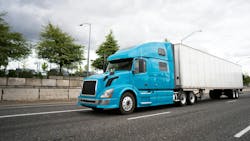Safety is a team sport: How cross-functional alignment strengthens fleet culture
Key takeaways
- Safety must be a collective effort across the organization, making it a core value rather than just a compliance task.
- A strong safety culture relies on trust and consistent communication between safety and operations teams.
- Clear safety goals and visible performance metrics at all levels foster accountability and continuous improvement.
When people think of safety in fleet operations, they often think of policies, safety equipment, technology, or driver behavior. But behind every successful safety program is something less obvious: teamwork.
Safety isn’t the job of a single group. It’s a shared responsibility that only succeeds when the entire organization is aligned. Teamwork ensures that everyone is not just on the same page but also working together to stay there.
Safety must be operationally driven
At many fleets, safety is seen as a standalone department that trains drivers, reviews incidents, and ensures compliance. But the most effective safety programs I’ve seen are operationally driven. That means operations, not just safety, owns the outcomes. They see safety not as an external function, but as a core part of their job—and they’re not just involved but accountable.
That mindset shift changes everything. Having operations accountable for safety ensures that drivers receive consistent messages from the people they report to daily. It’s not “safety says we have to do this,” it’s “here’s how we’re going to do this together.” It reinforces the idea that safety isn’t a box to check but a value that underpins how we operate as a team.
Building trust between safety and operations
A high-functioning safety culture depends on trust, especially between safety and operations teams. Both sides must be able to count on each other to do what’s right for the driver and the fleet. Safety teams must provide operations teams with the data, context, and tools they need to engage drivers effectively, and operations must act on this information with urgency and consistency.
As a safety professional, I believe that operations should be provided with all the resources they need. Fleet managers are busy and simply don’t have the time to dig through video, telematics, and incident reports. It’s our job to make it easy for them to act by putting the correct information in front of them so they can have informed, productive conversations with drivers.
See also: An evolving safety program has proven the strength of this fleet’s safety culture
One language, one team
At fleets where safety and operations are in sync, you’ll notice something subtle but powerful: They speak the same language. That doesn’t happen by accident, but rather in organizations where everyone undergoes the same training. Office staff does not need to know how to drive a truck, but they should know what “lean and look” means and the following distance standards drivers must abide by. When safety and operations teams use the same phrases, drivers hear one message.
In one company I worked with, we trained all office personnel in the same safety principles we used with drivers, so that when fleet managers coached drivers, they did so with confidence and clarity. It also meant we avoided the common pitfall of operations blaming safety (or vice versa) when something went wrong.
Joint reviews create shared accountability
When an accident happens, the default at many fleets is to send the driver to safety. In an ideal world, safety and operations should review an incident together to understand what happened and how it could be prevented in the future. This process should also apply to injuries, on-road citations, video-triggered events, etc. The logic of cross-functional reviews is simple: Involving operations in every review helps reinforce the message that safety isn’t “their” job—it’s ours.
When it comes to this type of teamwork, consistency also matters. Regular meetings between operations and safety teams to review safety performance, answer questions, and preview upcoming training help reinforce expectations and ensure everyone is pulling in the same direction.
Fleet managers must own safety metrics
To create real buy-in, safety performance must be visible, measured, and shared. Companies must set clear safety goals and cascade them down to the fleet manager level. Every manager must know what their targets are and understand how hitting those targets contributes to the company’s success.
At another company I worked with, we even publicly ranked fleet managers by safety performance—not to shame anyone but to celebrate the best, identify who needed support, and create opportunities to share best practices. That level of visibility not only creates healthy competition but also gives managers an added incentive to care about safety behavior and risk reduction.
Teamwork is what makes safety stick
At the end of the day, safety culture isn’t something you can just mandate from the top. It’s something you build day by day throughout the organization. By reinforcing shared goals, shared accountability, and shared respect, teamwork turns policies into practice. A culture of safety is only as strong as the team behind it—and teamwork helps ensure that culture endures.
Safety is a team sport, and when everyone is aligned, everyone wins.
This article is the second in a four-part series on building a safer fleet through culture, training, teamwork, and technology. You can read Part 1 here.
About the Author

Gary Falldin
Gary Falldin is the senior director of industry solutions at Platform Science. Falldin has more than 35 years of experience in the transportation industry, first with UPS and then in OTR. He currently serves on the Safety Committee Leadership team for the Minnesota Trucking Association and on safety committees with ATA, TCA, and CVSA.
